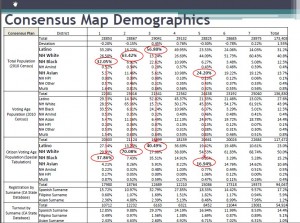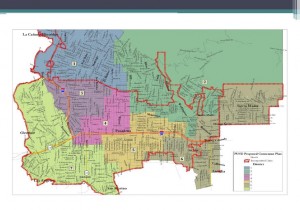Posted 6/4/12 – At the City Council meeting on May 22nd, the City Council received an update from its representative on the PUSD Redistricting Task Force, Bart Doyle. Mr. Doyle replaced Joe Mosca as the city’s representative when he resigned to move to London.
Despite his late entry into the process, Mr. Doyle was able to give a full and comprehensive report on the current status, and what the Redistricting Task Force has accomplished through a series of more than sixty meetings. Measure A in tomorrow’s election will determine if the voters in the area want to implement the recommendations of the Task Force. You can click here to view a .pdf of the PowerPoint presentation made by Mr. Doyle (slides only), or view (audio and video of) the entire presentation made by Mr. Doyle to the Council by clicking to view the video below.
On Nov. 23, 2010, the PUSD Board endorsed changing the method of elections from the current at-large voting method to geographic sub-district representation. At the February 15, 2011 Joint Meeting of the Pasadena Unified School District Board of Education and City Council of Pasadena, the governing bodies approved the process for a Charter Amendment and sub-geographic districting for the Board of Education Members, and called for a special election. The reason for the change:
• Greater access to public elected Board Members
• Smaller constituent base – Easier interaction
• Higher level of public interest in education
• Lower cost for candidates
• Lower cost for District
• Avoidance of potential costly litigation (According to the impartial analysis of Measure A by the Pasadena City Attorney, continuing to have an at-large system of voting “has been asserted to violate the California Voting Rights Act for not providing proper representation of the diverse interests of the voters, and could result in potential liability for damages, fees and costs if it were challenged in court.”
A Task Force was appointed, whose charge was to
• “Review the 1999-2000 Charter Amendment proposal (Measure BB) for sub-geographic district elections of PUSD Board Members, and determine what changes are necessary in order to forward to the voters.”
• “Determine, through the use of 2010 Census data and receiving community input, the geographic regions for the seven seats for PUSD Board of Education, ensuring compliance with the State and Federal Voting Rights Act provisions.”
The Task Force members are: Ken Chawkins, Chair, Richard Moon, Vice Chair, and Pixie Boyden, Bernardean Broadous, Khatchik “Chris” Chahinian, Dr.Victor Gonzalez, Roberta Martinez, Bart Doyle (replacing Joe Mosca), and Diana Peterson. Every ten years, following the federal census, the process will be repeated. Additionally, any other time 2/3 of the Board decides sufficient population change has occurred to justify updating the lines, redistricting could occur.
In determining the geographic regions for the seven seats on the Board, the Task Force was to avoid:
• Gerrymandering – Establishing an unfair political advantage for or against one group through the manipulation of geographic boundaries.
• Packing – Concentrating as many voters of a particular group into a single electoral district to reduce their influence in other districts.
• Cracking – Spreading out voters of particular group among multiple districts in order to deny them a large voting bloc of any one district.
Key criteria adopted by the Task Force in November of 2011 for determination of geographic sub-districts were:
• Socio-Economic
• Race, ethnicity, linguistics
• “Natural” geographic boundaries
• School attendance zones, locations, and attendance patterns
The map was approved by the Board on May 9, 2012. According to Doyle: “This is…essentially the map that the Task Force came up with and recommended to the Board.” Due to the complexity of the process particularly as it effects the City Clerk, the maps were changed by about two blocks in the Chapman Woods area to conform to Precinct boundaries, with a head count change of about 17 votes.
The map as approved seems to favor Sierra Madre in that the population of Sierra Madre represents 37% of the population of District 6, but the number of registered voters in District 6 is about 44%. Considering that Sierra Madre generally has a higher turnout of voters than other areas of the District, there may be an additional bias toward Sierra Madre.
Seats 1, 3, 5 and 7 will be elected in 2013, and seats 2, 4 and 6 would be elected in 2015. The will of the voters for elections held in 2011 or before were to be honored. According to Richard Moon, vice-chair, in his blog discussion on Sierra Madre Patch, “The answer is that it made the most sense to assign the districts where the existing incumbents’ terms were going to be up at a particular year to have their sub-district election that year (that is, the one where there are two incumbents both up for election in 2013, that area should go up in 2013; where there are two up in 2015, that area goes up in 2015., etc). That started us in a direction that, while we weren’t necessarily married to it, made a certain geographical sense, and which set Central Pasadena as being an even-numbered seat, and south-central Pasadena and San Rafael as being odd. It was then decided that setting West Altadena as odd would face the least amount of opposition from the incumbents there… Since putting both halves of Altadena up at the same time seemed like a bad idea (fears of encouraging balkanization), that set Eastern Altadena as even.
 Moon continues “The question was then of either setting Sierra Madre et al at Odd (and Northwest Pasadena to Even), and thus creating a sort of weird SOUTH block which would wind up creating some sort of north-vs-south dynamic, or setting it to Even (and setting Northwest Pasadena to Odd), and thus delay Sierra Madre’s representative election by two years. We talked about that question for a long, long time, and most of us did our level-best to take up both sides of the question at different points, so that we weren’t just being an echo-chamber. Ken (Committee Chair Ken Chawkins) stayed pretty much silent on the issue, while Bart argued very strongly for SM being an odd seat. …we heard a *lot* more voices from NW Pas who desperately wanted a rep and felt that they were unrepresented on the current board than we heard from Sierra Madre. That isn’t to say that the voices we heard from SM weren’t listened to; they were. There were just more and more passionate voices from NW Pas, really. The vast majority of input we got from the residents of SM was “meh, why bother, won’t change anything, anyway.”
Moon continues “The question was then of either setting Sierra Madre et al at Odd (and Northwest Pasadena to Even), and thus creating a sort of weird SOUTH block which would wind up creating some sort of north-vs-south dynamic, or setting it to Even (and setting Northwest Pasadena to Odd), and thus delay Sierra Madre’s representative election by two years. We talked about that question for a long, long time, and most of us did our level-best to take up both sides of the question at different points, so that we weren’t just being an echo-chamber. Ken (Committee Chair Ken Chawkins) stayed pretty much silent on the issue, while Bart argued very strongly for SM being an odd seat. …we heard a *lot* more voices from NW Pas who desperately wanted a rep and felt that they were unrepresented on the current board than we heard from Sierra Madre. That isn’t to say that the voices we heard from SM weren’t listened to; they were. There were just more and more passionate voices from NW Pas, really. The vast majority of input we got from the residents of SM was “meh, why bother, won’t change anything, anyway.”
Districts 2, 3 and 6, have no current Board members living in them. To “capture” a School Board member in District 6 to be able to vote in 2013 for a Sierra Madre representative would have required major adjustments to the map that would have drastically “diluted our registration and population, and lost our predominant position in that District 6 and might destabilized District 5..” said Doyle. According to Doyle “There really is no good tradeoff that we were able to identify…This is not an ideal result, it does move us where we would have a chance in two years (sic) where we can finally elect a School Board member…”
Measure A requires approval of a majority of the voters. A Yes vote for Measure A will support PUSD Board elections by voting districts, a No vote against Measure A will support voter elections from across the entire district.
City Clerk’s Impartial analysis of Measure A
School District web page regarding District Initiative on Measure A

